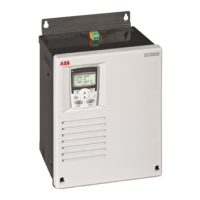59
Start-up
3ADW000379R0501 DCS550 Manual e e
Start-up
Chapter overview
This chapter describes the basic start-up procedure of the drive. A more detailed description of the signals
and parameters involved in the procedure is available in section Signal and parameter list.
General
Operate the drive:
− local, with DWL or DCS Control Panel
− remote, with local I/O or overriding control.
The following start-up procedure uses DWL (for further information about DWL, consult its online help).
However, it is possible to change parameters with the DCS Control Panel. The start-up procedure includes
actions that need only be taken when powering up the drive for the first time in a new installation (e.g. entering
the motor data). After the start-up, the drive can be powered up without using these start-up functions again.
Repeat the start-up procedure, if the start-up data need to be changed.
Refer to section Fault tracing
in case problems should arise. In case of a major problem, disconnect mains
and wait for 5 minutes before attempting any work on the drive, the motor, or the motor cables.
Commissioning
Start-up procedure
Observe the Safety Instructions at the beginning of this manual with extreme care during the
start
-up procedure! Only a qualified electrician should carry out the start-up procedure.
Tools
For drive commissioning following tools are mandatory:
− standard tools,
− an oscilloscope including memory function with either galvanically isolating transformer or isolating
amplifier for safe measurements,
− a clamp on current probe (in case the scaling of the DC load current needs to be checked it must be a DC
clamp on current probe),
− a voltmeter and
− DriveWindow Light including commissioning wizard and DWL AP.
Make sure that all equipment in use is suitable for the voltage level applied to the power part!
Checking with the power switched off
Check the settings of:
− the main breaker (e.g. overcurrent = 1.6 * I
n
, short circuit current = 10 * I
n
, time for thermal tripping = 10 s),
− time, overcurrent, thermal and voltage relays,
− the earth fault protection (e.g. Bender relay)
Check the insulation of the mains voltage cables between the secondary side of the supply transformer and
the drive:
− disconnect the supply transformer from its incoming voltage,
− check that all circuits between the mains and the drive (e.g. control / auxiliary voltage) are disconnected,
− measure the insulation resistance between L1 - L2, L1 - L3, L2 - L3, L1 -PE, L2 - PE, L3 - PE,
− the result should be MΩs
Check the installation:
− crosscheck the wiring with the drawings,
− check the mechanical mounting of the motor and pulse encoder or analog tacho,
− make sure that the motor is connected in a correct way (armature, field, serial windings, cable shields),
− check the connections of the motor fan if existing,
− make sure that the converter fan is connected correctly,

